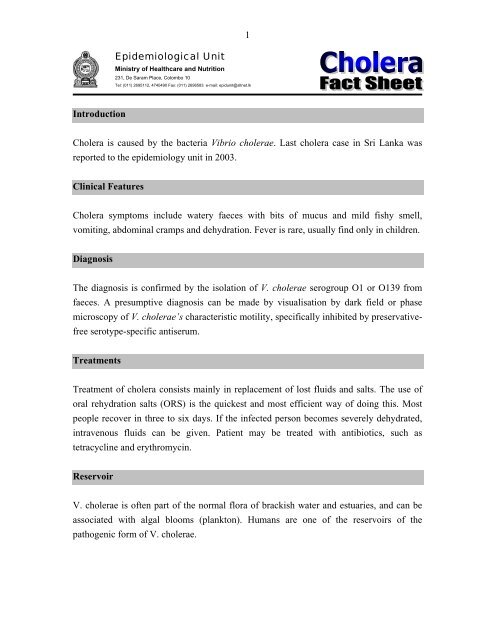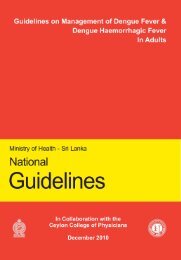Fact Sheet Cholera - Sri Lanka Epidemiological Unit
Fact Sheet Cholera - Sri Lanka Epidemiological Unit
Fact Sheet Cholera - Sri Lanka Epidemiological Unit
You also want an ePaper? Increase the reach of your titles
YUMPU automatically turns print PDFs into web optimized ePapers that Google loves.
Introduction<br />
<strong>Epidemiological</strong> <strong>Unit</strong><br />
Ministry of Healthcare an d Nutrition<br />
231, De Saram Place, Colombo 10<br />
1<br />
Tel: (011) 2695112, 4740490 Fax: (011) 2696583 e-mail: epidunit@sltnet.lk<br />
<strong>Cholera</strong> is caused by the bacteria Vibrio cholerae. Last cholera case in <strong>Sri</strong> <strong>Lanka</strong> was<br />
reported to the epidemiology unit in 2003.<br />
Clinical Features<br />
<strong>Cholera</strong> symptoms include watery faeces with bits of mucus and mild fishy smell,<br />
vomiting, abdominal cramps and dehydration. Fever is rare, usually find only in children.<br />
Diagnosis<br />
The diagnosis is confirmed by the isolation of V. cholerae serogroup O1 or O139 from<br />
faeces. A presumptive diagnosis can be made by visualisation by dark field or phase<br />
microscopy of V. cholerae’s characteristic motility, specifically inhibited by preservative-<br />
free serotype-specific antiserum.<br />
Treatments<br />
Treatment of cholera consists mainly in replacement of lost fluids and salts. The use of<br />
oral rehydration salts (ORS) is the quickest and most efficient way of doing this. Most<br />
people recover in three to six days. If the infected person becomes severely dehydrated,<br />
intravenous fluids can be given. Patient may be treated with antibiotics, such as<br />
tetracycline and erythromycin.<br />
Reservoir<br />
V. cholerae is often part of the normal flora of brackish water and estuaries, and can be<br />
associated with algal blooms (plankton). Humans are one of the reservoirs of the<br />
pathogenic form of V. cholerae.
Communicability<br />
2<br />
Persons are infectious during the acute stage and for a few days after recovery. By the<br />
end of the first week 70% of patients are non-infectious. By the end of the third week<br />
98% are non-infectious. Occasionally the carrier state may persist for months and chronic<br />
biliary infection with intermittent shedding of organisms may last for years.<br />
Mode of transmission<br />
Transmission occurs through ingestion of contaminated water and food. Sudden large<br />
outbreaks are usually caused by a contaminated water supply. Raw or undercooked<br />
seafood may be a source of infection in areas where cholera is prevalent and sanitation is<br />
poor. Transmission due to direct person to person contact is rare.<br />
Incubation period<br />
Incubation period can be anything between a few hours and five days. Most people get<br />
symptoms after two to five days.<br />
Preventive measures<br />
• Only drink boiled cool water .<br />
• Eat freshly prepared food, cooked thoroughly and hot - in particular, don't eat raw<br />
or undercooked seafood.<br />
• Don't eat raw vegetables such as green salads as they may have been washed in<br />
contaminated water - only eat raw vegetables and fruit that you can peel.<br />
• Wash hands with soap and water after going to the toilet and particularly before<br />
handling food.




